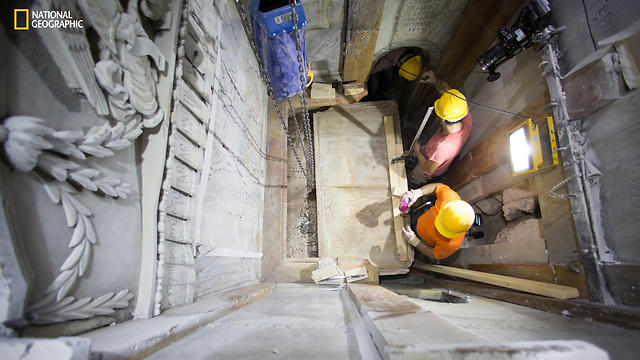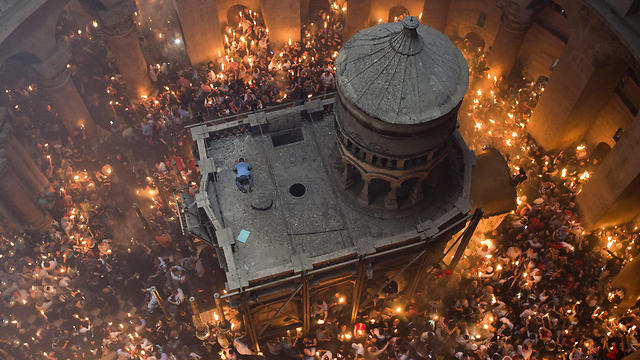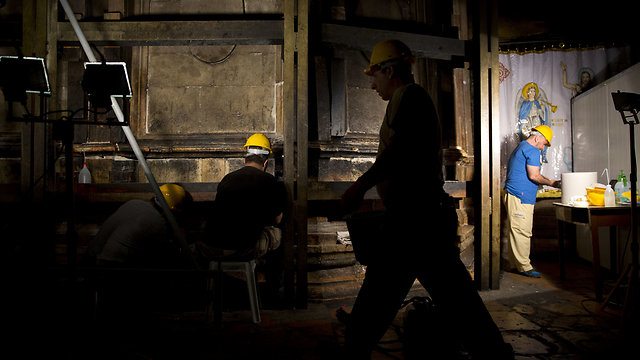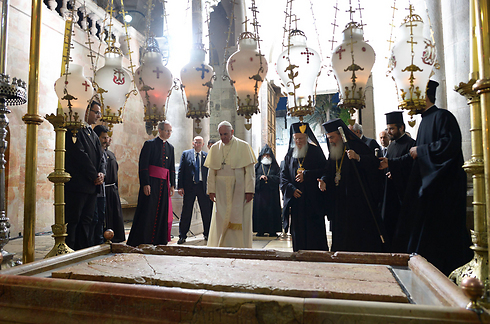Radar tests determined that cave walls are standing behind the marble panels of the chamber where Jesus’ body was laid before his resurrection; ‘What was found is astonishing.’
In the innermost chamber of the site said to be the tomb of Jesus, a restoration team has peeled away a marble layer for the first time in centuries in an effort to reach what it believes is the original rock surface where Jesus’ body was laid.

But an archaeologist accompanying the restoration team said ground-penetrating radar tests determined that cave walls are in fact standing — at a height of six feet and connected to bedrock — behind the marbled panels of the chamber at the center of Jerusalem’s Church of the Holy Sepulchre.
“What was found,” said National Geographic archaeologist Fredrik Hiebert, “is astonishing.”
The work is part of a historic renovation project to reinforce and preserve the Edicule, the chamber housing the cave where Jesus was entombed and resurrected. It is the centerpiece of one of Christianity’s oldest churches and one of its most important shrines.
“I usually spend my time in Tut’s tomb,” said Hiebert about the Egyptian pharaoh Tutankhamun’s burial site, “but this is more important.”
National Geographic is partnering with Greek restoration experts to document the work.
A 12th-century building sitting on 4th-century remains, the Church of the Holy Sepluchre is the only place where six Christian denominations practice their faith at the same site.
The Edicule was last restored in 1810 following a fire, and is in need of reinforcement after years of exposure to humidity and candle smoke. A hulking iron cage built around the Edicule by British authorities in 1947 for support still stands, but is not enough.

Renovations at this holiest of spots require mutual agreement by the church’s various custodians, and that is notoriously hard to secure. The denominations jealously guard different parts of the site and often object to even the slightest of changes. Last year, Israeli police briefly shut down the building after Israel’s Antiquities Authority deemed it unsafe. It prompted the Christian denominations to green light the repairs, which began in June.
Pilgrims line up throughout the day for the chance to crouch in the Edicule’s tiny room. They kneel before a white marble encasing, said to cover a surface hewn from the side of the limestone cave where Jesus’ body was laid before his resurrection.
Church officials closed the Edicule to pilgrims beginning Wednesday evening, and workers used a pulley to slide open the marble slab, in hopes of reaching the burial surface. Hiebert said the slab hadn’t been removed since the year 1550.
Underneath the marble was a layer of debris. By Thursday afternoon, workers had finished removing the debris, revealing something unexpected: another marble slab.

Hiebert said he thinks the second slab, which is grey and features a small etching of a cross, dates to the 12th century. It is cracked down the middle, and underneath it is a whitish layer.
“I don’t believe that is the original rock,” Hiebert said. “We still have more to go.”
The main Christian communities that govern the church have allowed the work crew only 60 hours to excavate the inner sanctum, Hiebert said. Experts are working day and night to reach the tomb’s core and to analyze it.
“We will close the tomb after we document it,” said Antonia Moropoulou, an architect at the National Technical University of Athens, which is supervising the renovation.
The restoration team wants to tightly seal the core of the tomb before injecting parts of the shrine with mortar for reinforcement, so the material doesn’t seep inside what is considered to be the holy rock.

One part of the tomb will remain exposed. Experts on Thursday cut a rectangular window in one of the Edicule’s marble walls, so pilgrims will be able to glimpse, for the first time, a part of the limestone wall thought to be the tomb of Jesus.
David Grenier, secretary of a group that oversees Roman Catholic Church properties in the Holy Land, stood with a few other Franciscan friars, watching the work crew in awe.
“What happened here 2,000 years ago completely changed the history of the world,” he said. “To be able to dig, let’s say, to the rock where the body of Jesus was laid, it’s overwhelming joy.”
As reported by Ynentews
